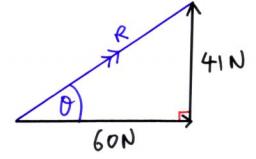Forces
Determine the resultant of two perpendicular forces F1 = 560 N and the second force 25% smaller.
Final Answer:

Tips for related online calculators
Our percentage calculator will help you quickly and easily solve a variety of common percentage-related problems.
See also our right triangle calculator.
See also our trigonometric triangle calculator.
See also our right triangle calculator.
See also our trigonometric triangle calculator.
You need to know the following knowledge to solve this word math problem:
arithmeticplanimetricsbasic operations and conceptsthemes, topicsGrade of the word problem
Related math problems and questions:
- Resultant force
 Calculate mathematically and graphically the resultant of three forces with a common center if: F1 = 50 kN α1 = 30° F2 = 40 kN α2 = 45° F3 = 40 kN α3 = 25°
Calculate mathematically and graphically the resultant of three forces with a common center if: F1 = 50 kN α1 = 30° F2 = 40 kN α2 = 45° F3 = 40 kN α3 = 25° - Mass point
 Two equal forces of 30 Newtons act on a mass point. Find the magnitude of the resultant force if these forces form an angle of 42°.
Two equal forces of 30 Newtons act on a mass point. Find the magnitude of the resultant force if these forces form an angle of 42°. - Perpendicular forces
 Distribute the force of magnitude F = 100 N into two perpendicular components with magnitudes F1 and F2 so that the angle between forces F1 and F is 43°52'.
Distribute the force of magnitude F = 100 N into two perpendicular components with magnitudes F1 and F2 so that the angle between forces F1 and F is 43°52'. - Two forces
 Two forces with magnitudes of 25 and 30 pounds act on an object at 10° and 100° angles. Find the direction and magnitude of the resultant force. Round to two decimal places in all intermediate steps and your final answer.
Two forces with magnitudes of 25 and 30 pounds act on an object at 10° and 100° angles. Find the direction and magnitude of the resultant force. Round to two decimal places in all intermediate steps and your final answer. - Two forces 3
 Two forces with magnitudes 8 Newtons and 15 Newtons act at a point. Find the angle between the forces if the resultant force is 17 Newtons.
Two forces with magnitudes 8 Newtons and 15 Newtons act at a point. Find the angle between the forces if the resultant force is 17 Newtons. - Acting
 Two locomotives are involved in a train set. One locomotive pulls the train, and the other pushes it. The pulling locomotive exerts a force of 500 kN on the train, and the pushing locomotive exerts a force of 400 kN. a) Draw a diagram of the described sit
Two locomotives are involved in a train set. One locomotive pulls the train, and the other pushes it. The pulling locomotive exerts a force of 500 kN on the train, and the pushing locomotive exerts a force of 400 kN. a) Draw a diagram of the described sit - Two forces
 The two forces, F1 = 580N and F2 = 630N, have an angle of 59 degrees. Calculate their resultant force, F.
The two forces, F1 = 580N and F2 = 630N, have an angle of 59 degrees. Calculate their resultant force, F.
